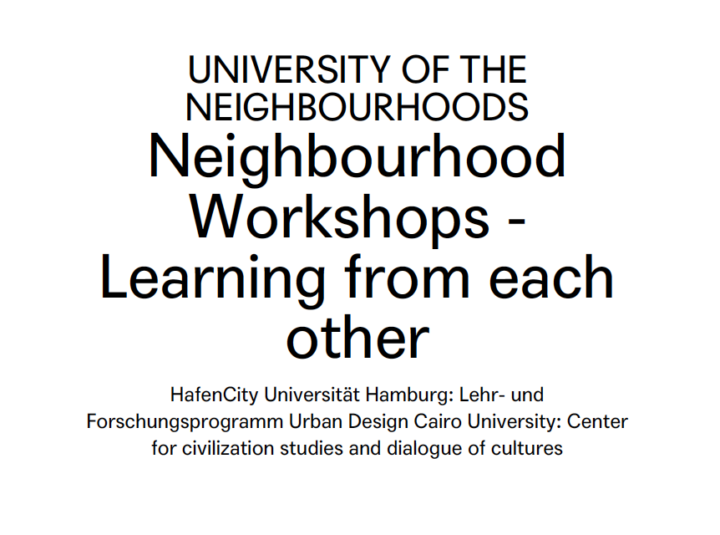Essay: Neighbourhood. A Notion in Transition

It is people who make a city tick. It is people who appropriate the city how they want it to be, and it’s people who define the future of the city. At least this is how we would like to think. For that to happen, a certain measure of non- conformity would be necessary so that people had a chance to appropriate the city they inhabit according to their needs and desires. In how far is restriction necessary? How would this affect the social and built-up structures? What form of governance would take place? Would there be total chaos and fear? And is there a space between appropriation and regulation? – Initiators
This publication is an output of the Workshop: Cairo Urban Transformation. Neighbourhood Workshop, in Hamburg from 21.08 – 30.08.2012 and Cairo from 21.09 – 30.09.2012. Organised by students for students. Cooperation between the Research and Teaching Programme Urban Design at HCU Hamburg and the Center for civilization studies and dialogue of cultures of Cairo University. The Project is funded by the DAAD.
Neighbourhood. A Notion in Transition
Christopher Dell
Ausschnitt aus dem Essay:
The notion of neighbourhood is extraordinarily intricate, and, due to this difficult if not impossible to generalize. We can think of particular sites, the neighbourhood in our house, in our street, a neighbourhood in a Paris residential quarter, a Frankfurt Bank District or a neighbourhood next to a Detroit industrial site or in a small village in Brandenburg and so on. All these sites are extremely different: in size, structure, form, function and scale. These examples indicate that we cannot longer even agree on what counts as a neighbourhood.
Yet I argue that the notion itself, just because of such intricacy, is nonetheless evermore valid for urban design discourse. Let us look at the basics: neighbourhood is a relational notion. The condition of neighbouring is based on the fact that there are always two entities: a person and a person next to the person or a thing and a thing next to it – neighbouring cannot take place individually, a neighbourhood cannot exist on its own. That holds equally true for the topological dimension of the notion. Concerning the second dimension – the social – things turn out in even more complex ways. While the first dimension of neighbourhood concerns geographical place (physical space, built environment), the second aspect refers to social practice. The definition of the second aspect is problematic in that in itself it is grounded in certain qualities of the topological – the ‘social’ – that inevitably are a matter of social debate themselves.
Social geography speaks of the neighbourhood as a place based on the connectivity of territories (Nystuen 1970 ). Sociology defines the neighbourhood as ‘a social group that interacts on the basis of physical proximity’ (Hamm 1973) . This definition is based on the assumption that ‘a social group is defined by the interactions between its members’ (Homans 1968). But not only is social action, i.e. changes in definition according to historical changes of knowledge, hard to define. It also lends itself to an overestimation of a quality of place, to an overestimation of a social nativity or the immediacy of a social place called neighbourhood. Mumford, for example, refers to the neighbourhood as a connectivity of place that he understands as the most original form of social relations (Mumford 1967: 115).
